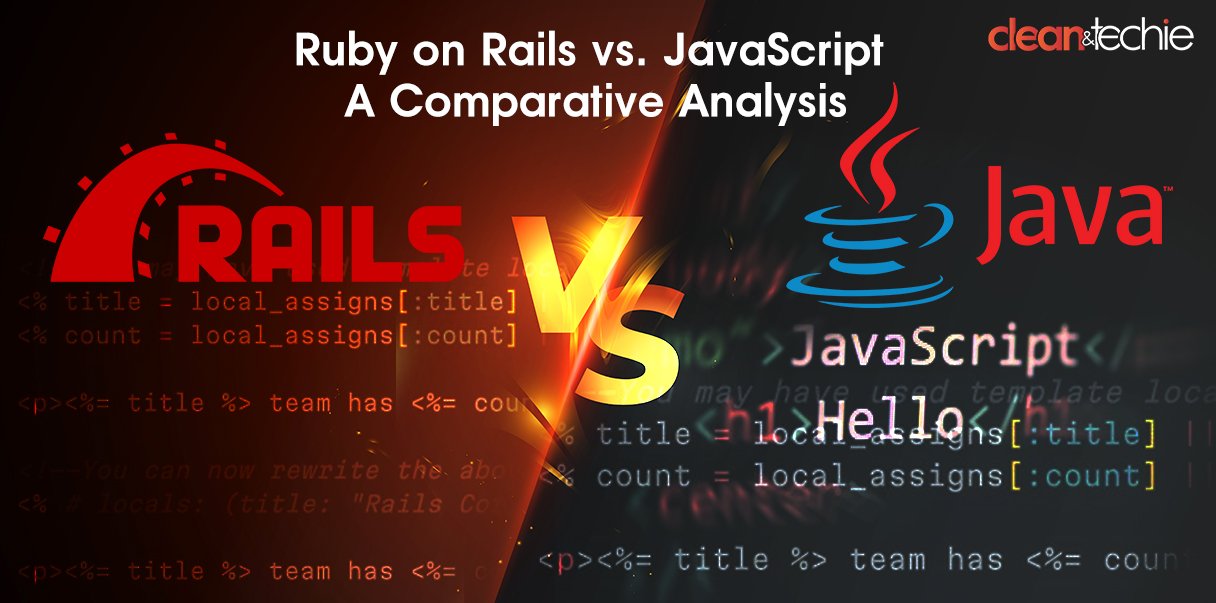Ruby on Rails Vs Javascript: which one to choose when venturing into a web development project?
Choosing the right technology stack is the first and the most important step. Ruby on Rails and JavaScript are the two most popular options. Each has its unique strengths and weaknesses, making it essential to understand their differences before making the final decision.
We will get into a little more detail and do comparative analysis of Ruby on Rails Vs JavaScript. Let’s explore their key features, use cases, and potential advantages and disadvantages.
JavaScript supports two separate coding languages, i.e., Node.js for the backend and AnguarJS for frontend development. While Ruby On Rails can handle both backend and frontend, providing a complete solution.
Ruby on Rails: A Framework for Rapid Development
Ruby on Rails, often referred to as Rails, is a full-stack web application framework written in the Ruby programming language. It is renowned for its convention over configuration approach, which promotes rapid development by providing sensible defaults for common tasks. This framework is designed to simplify the development process and help developers build robust and scalable web applications efficiently.
Key Features of Ruby on Rails:
Convention over configuration:
Rails does a lot of the setup work for you, so you don’t have to spend as much time configuring things.
MVC architecture:
The Model-View-Controller (MVC) pattern helps keep your code organized. This makes it easier to maintain and update your application.
Generators:
Rails has built-in tools that can help you quickly create the basic parts of your web application, like the structure, data models, and the parts that show information to the user.
RESTful API:
Ruby on Rails is a popular web framework that excels at building RESTful APIs. It offers features like convention over configuration, resource-based architecture, JSON support, routing, testing tools, Active Record, and a strong community. These features make it efficient for developers to create well-structured, scalable, and maintainable RESTful APIs.
Use Cases for Ruby on Rails:
Enterprise applications:
A lot of developers prefer Ruby on Rails framework for building enterprise applications. Its rapid development, scalability, maintainability, and strong community make it a suitable choice. It can be used for various applications like CRM, ERP, CMS, e-commerce, and BI.
E-commerce platforms:
Ruby on Rails is ideal for e-commerce platforms. Its rapid development, scalability, and robust features make it a great choice. RoR offers a strong ecosystem for tasks like payment processing, shopping cart management, and inventory control. Developers can build feature-rich e-commerce platforms efficiently using Ruby On Rails.
Social networking sites:
Its rapid development capabilities, scalability, and emphasis on maintainability make it well-suited for handling the dynamic nature of social platforms. RoR’s features like user authentication, content management, and real-time updates can be efficiently implemented to create engaging and scalable social networking experiences.
Startups:
Ruby on Rails is ideal for startups.
Its rapid development and scalability, combined with a strong community and ecosystem, make it a great choice for quickly building robust applications.
JavaScript: The Language of the Web
JavaScript is a client-side scripting language that adds interactivity to web pages, enabling real-time updates and engaging user experiences. It enables dynamic and interactive web pages, allowing for real-time updates and user engagement. While JavaScript can also be used for server-side development with frameworks like Node.js, its core strength lies in its ability to enhance the user experience on the web.
Key Features of JavaScript:
DOM manipulation:
JavaScript interacts with the DOM by using methods and properties to access, create, modify, and delete elements, attributes, and text content within a web page.
Asynchronous programming:
JavaScript’s asynchronous nature allows it to handle multiple tasks simultaneously without blocking the main thread. This is crucial for tasks like network requests and data fetching, as it prevents the UI from freezing while waiting for responses.
Event handling:
JavaScript’s event-driven nature allows it to respond to user interactions. It uses event listeners to attach functions to specific events, like clicks or key presses. When these events occur, the associated functions are executed, enabling dynamic and interactive web pages.
Use Cases for JavaScript:
Front-end development:
Front-end development heavily relies on JavaScript. It’s used to create interactive user interfaces, handle dynamic content, validate forms, and enhance the overall user experience. JavaScript is useful in adding responsiveness and interactivity to websites making them more dynamic.
Single-page applications (SPAs):
(SPAs) rely heavily on JavaScript for dynamic user interfaces. SPAs load the entire application’s code upfront, then dynamically update the page content without reloading the entire page, providing a more fluid and responsive user experience.
Cross-platform development:
Cross-platform development allows creating applications that run on multiple platforms (like web, iOS, and Android). JavaScript’s versatility and wide browser support make it a key tool for building cross-platform applications, especially with frameworks like React Native and Electron.
Comparative Analysis: Ruby on Rails Vs Javascript
| Feature | Ruby on Rails | JavaScript |
| Purpose | Full-stack web framework | Client-side scripting language |
| Programming language | Ruby | JavaScript |
| Development approach | Convention over configuration | Flexible and customizable |
| Architecture | MVC | Does not use inherent architecture |
| Use cases | Enterprise applications, e-commerce, social networking | Front-end development, SPAs, hybrid apps |
| Performance | Generally good, can be optimized | Can be optimized with techniques like code minification and bundling |
| Learning curve | Relatively easy for Ruby developers | Can be challenging for beginners, but frameworks simplify development |
Conclusion
The choice between Ruby on Rails and JavaScript depends on the specific requirements of your web development project. Ruby on Rails is a powerful framework for building robust and scalable web applications quickly. JavaScript is essential for creating interactive and dynamic user interfaces, especially for SPAs and hybrid apps.
If you prioritize rapid development, convention over configuration, and a full-stack framework, Ruby on Rails might be the ideal choice. However, if you need more flexibility and control over the client-side experience, JavaScript is the way to go. Ultimately, the best approach is to evaluate your project’s needs and consider the strengths and weaknesses of each technology before making a decision.




